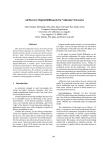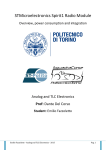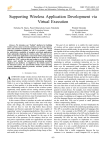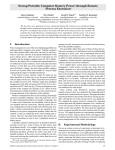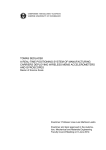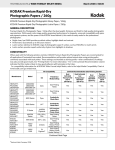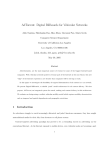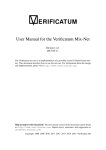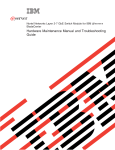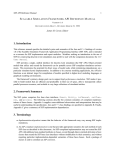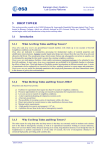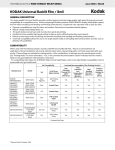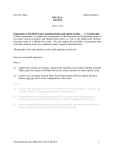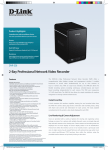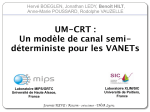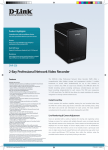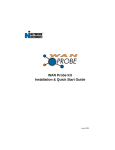Download Scalable OSPF Updates for MANETs - North Carolina State University
Transcript
Scalable OSPF Updates for MANETs
Jangeun Jun and Mihail L. Sichitiu
Department of Electrical and Computer Engineering
North Carolina State University
Raleigh, NC 27695
email:{jjun,mlsichit}@ncsu.edu
Abstract— Recently, mobile ad hoc networks (MANETs) have
evolved as an irreplaceable networking technology for situations
with sparse or inexistent infrastructure. Adapting OSPFv3 to
MANET environments has several advantages. The protocol
has proven its maturity in the wired Internet and is now the
de facto standard Intra-AS routing protocol. When used in
wireless ad hoc networks with proper extensions, OSPFv3 can
provide better interoperation between the ad hoc domain and
the Internet. This is one of the essential requirements for any
ad hoc networks (including wireless mesh networks) that require
connectivity to the Internet. The main challenge is that since
OSPF is highly optimized for wired-oriented environment, it
needs further enhancement to be fully functional in ad hoc
scenarios. The most serious obstacle is the large routing overhead
associated with the frequent topology changes due to volatile
wireless links and node mobility. Various overhead reduction
schemes have been proposed by focusing on how to reduce
hello packets, flooding nodes, or the number of adjacencies. We
propose a completely different approach by taking into account
the very essential characteristics of wireless ad hoc networks namely, distance effect. We implemented the proposed scheme on
a simulator that uses the real OSPFv3 as its routing module. The
simulation experiments prove that the proposed scheme allows
significant reduction in OSPF routing overhead at small loss of
route optimality.
I. I NTRODUCTION
TO
S CALABLE U PDATES IN MANET S
The main characteristic of ad-hoc networks is the absence
of pre-planning. The topology of the network is discovered
on the fly, after the network’s deployment. Thus, such a
network must exchange a number of messages which are
used to “set-up” various parameters in the network. Example
of such parameters are the very existence of other nodes in
the network, their position, information about their neighbors,
what they offer (e.g., local maps, files, printing facilities).
The location information and the neighbors will change with
mobility, and thus will have to be updated. As the number of
nodes and the mobility increases, the updates will start to be
a significant percentage of the total traffic in the network, and
at some point, the network will not be able to carry all the
updates, let alone the “useful” user traffic.
Information about other nodes’ neighbors and/or their location (as well as distance vector or link state information) is
especially useful in routing. On one hand routing is essential
for the functioning of the ad-hoc network, so one cannot do
without it. On the other hand the updates consume available
1 This
work was supported by the Center for Advanced Computing and
Communication.
bandwidth in the ad-hoc network. The bandwidth consumed by
the control overhead reduces the bandwidth for user applications. This leads to a significant problem in typical MANETs
where bandwidth and processing power are scarce resources.
Various schemes have been proposed to alleviate the overhead problem in MANETs. Fisheye State Routing (FSR) [1]
is a link state routing protocol for MANETs that attempts
to address the scalability problem. The main idea of FSR
is that the updates corresponding to closer nodes propagate
more frequently. Since the topology map maintained at each
node relies on periodic link state packets that are not flooded
as in conventional protocols, it is expected to require less
overhead than other link state protocols with full flooding.
OLSR [2] is another link state routing protocol for MANETs
that reduces the overhead by reducing the number of nodes
participating in link state flooding. Some protocols (e.g.,
[3] [4]) rely on clustering scheme to contain the overhead
within a certain boundary. DSR [5] uses aggressive caching
to reduce the flooding. Location information is often incorporated into routing protocols to reduce the overhead and
increase the scalability. Some examples are LAR [6], DREAM
[7] and ZRP [8]. Existing solutions show improvements in
flooding overhead using different approaches. However, they
require additional protocol complexity (e.g., formation and
maintenance of routing hierarchy), storage (e.g., caching) or
information (e.g., location).
We aim at providing a distributed, efficient and scalable
scheme that can be either applied to existing protocols as an
extension or implemented as a stand-alone protocol. The main
characteristics of the proposed scheme can be described as:
•
•
•
•
It does not rely on any external information other than
simple network layer information readily available (e.g.,
hop count).
It is fully distributed and simple enough to require no
central control of the topology.
It has the analytical property that the overhead asymptotically increases as O(1) with the scaled network size.
It is not protocol-specific and thus, it can be easily
applied to almost all the classes of existing ad hoc
routing protocols that employ flooding as its main or
supplementary mechanism.
OSPF [9] is by far the most popular intra autonomous
system routing protocol in the Internet. In the latest version
(OSPF for IPv6 [10]), the protocol was dissociated from the
4
3
7
char from_node[n] = {'y','y','y',....,'y'};
1
6
8
9
5
11
10
2
12
13
21
14
20
A
proces_update (received_update)
{
if (from_node[received_update->source] == 'y')
{
from_node[received_update->source] == 'n';
forward (received_update);
}
else
{
from_node[received_update->source] 'y';
}
}
15
19
Fig. 2.
18
16
Pseudo-code for processing the received updates.
17
15
Fig. 1. When node 15 moves from point A to point B, it must send updates
to other nodes such that those nodes will be able to reach it.
addressing scheme. This change allows the protocol to work
not only with IPv6 addresses but with more general addressing
schemes. Adapting OSPFv3 to MANET environments has several advantages. The protocol is mature in the wired Internet
and is now the de facto standard. When used in wireless ad hoc
networks with proper extensions, OSPFv3 can provide better
interoperation between the ad hoc domain and the Internet.
The most serious obstacle in using OSPF in MANETs is the
large flooding overhead associated with the frequent topology
changes. We propose to use the scheme described above to
alleviate this problem.
II. P ROPOSED S OLUTION
In many MANET protocols, the updates are done by flooding [2], [11]. This means, that when a node needs to update
the others it will send (i.e., locally broadcast) the update to
all its neighbors, and the neighbors to their neighbors, and so
on. In this way, the update will eventually reach all nodes.
Assume that in Fig. 1, node 1 wants to send a message to
node 15. When node 15 is in position A the messages from
1 to 15 will likely use the following route: 1-5-10-21-14-15.
When node 15 moves to position B the route will likely be:
1-5-10-21-18-15. The first hop of node 1 is node 5 regardless
of the position of node 15. Thus, we can say that 15’s update
going all the way to 1 is “useless”. On the other hand, the route
from node 12 to node 15 changes substantially when node 15
moves. The general rule is that the closer neighbors should be
updated more often than the nodes which are far away. The
idea is present in other papers [7], [1] but the implications
were not fully explored.
A different way to update is not to forward all the updates,
but only a few of them. For example, a node may forward only
half of the updates it receives. Figure 2 depicts the pseudocode of the routine processing the received updates. Under
this policy, the nodes one hop away from the node sending
the updates will get all updates, the nodes two hops away will
get half of the updates, the nodes three hops away will get
a quarter of the updates, etc. A node h hops away from the
1
source of the updates will get 2h−1
of the updates.
Fig. 3. A regular chain topology chosen for the analysis of asymptotic
efficiency.
A. Analysis
In this section, the asymptotic efficiency of the proposed
scheme is presented. Two regular topologies are considered in
this analysis. We first define some important variables used
commonly in the analysis of the two cases as follows:
• k ≡ the total number of updates generated at the center
node
• i ≡ the distance (i.e., number of hops ) between the center
node and another node in the network
• N (i, k) ≡ the total number of updates (including both
the generated updates at the center node and the relayed
updates by other nodes) as a function of i and k
• R(i) ≡ the update generation rate induced by the center
node in the network of diameter i, R(i) = N (i,k)
k
• β ≡ the update relaying factor (0 < β < 1) at each node,
e.g., one out of every β1 arriving updates is relayed in
exponential reduction
We investigate the overhead reduction efficiency for the
chain topology and then extend the method to the grid topology. Figure 3 illustrates the chain topology under consideration. We focus on the effect of the updates generated at the
node located in the center of the network, namely the center
node. Assuming full flooding scheme is being used, we can
express N (i, k) and R(i) as:
Nf looding (i, k) = 2k + ... + 2k = 2ik,
Rf looding (i) =
(1)
2ik
= 2i = Θ(i).
k
(2)
If the proposed scheme is applied to the same scenario, the
resulting N (i, k) and R(i) will become:
Nnew (i, k) = 2k
i
X
l=1
β l = 2k
β(1 − β i )
1−β
(3)
"!
#!
$!
%!
!
Fig. 4.
A regular grid topology chosen for the analysis of asymptotic
efficiency.
Rnew (i) =
2β
1 − β i = Θ(1).
1−β
(4)
The results from (2) and (4) indicate that the asymptotic
update generation of the new scheme provides significant
enhancement in scalability over the full flooding scheme.
Figure 4 illustrates the grid topology. We investigate the
effect of the updates generated at the center node using the
same variables used in the chain topology case. With full
flooding scheme, N (i, k) and R(i) are:
"
!
#
i
X
Nf looding (i, k) =
8
l − 4i k = 4ki2 ,
(5)
l=1
4ki2
= Θ(i2 ).
(6)
k
If the proposed scheme is used, the resulting N (i, k) and
R(i) will become:
Rf looding (i) =
Nnew (i, k) = 4k
i
X
lβ l
l=1
=
4kβ
(β − 1)
2
(βi − i − 1)β i + 1
(7)
Nnew (i, k)
= Θ(1).
(8)
k
The results from the grid topology is consistent with the
chain topology. Equations (6) and (8) show that the asymptotic
update generation of the new scheme has significantly reduced
overhead compared to the full flooding scheme. Note that the
result holds for any β that satisfies 0 < β < 1. Therefore, β
can be varied depending on the performance requirement.
Rnew (i) =
B. Parameters
The proposed scheme provides great flexibility because it
turns into virtually infinite number of variations by simply
changing a few parameters.
The scheme used for analytical result in Section II-A is
a specific case where the number of relayed updates are
exponentially reduced as they propagate from the center of
Fig. 5.
Overhead reduction behavior can be customized by configuring
prescaler parameters.
the generating node. We define “prescaler” as the entity that
performs the functionality of overhead reduction and β as the
prime parameter that determines the intensity of reduction.
Note that the prescaler need not always be exponential, rather,
it can be hyperbolic or linear depending on the design of
a certain routing protocol. Thus, the prescaler’s “mode” is
another parameter that can be used to customize the reduction
behavior.
The two parameters of mode and β affect the functionality
of the prescaler in a deterministic manner. That is, when a
node receives an update, it determines whether or not to relay
it based on a predefined schedule (e.g., relay two for every five
received updates). On the other hand, the decision need not
be hard fixed. Sometimes it is complicated to come up with
a clear cut schedule for a given overhead reduction goal. In
such a case, one can employ a scheme that makes the relaying
decision based on a random function with parameter β. This
provides another prescaler parameter that allows one to fine
tune the reduction operation.
In many cases, the closest neighbors (e.g., within one or
two hop distance) of a node require highly accurate update
information. One example is that a node moves away from its
neighbor and the neighbor does not realize the lost link until
the update arrives detouring the previous link. This problem
can be solved if the detouring update travels fast enough up to
a certain distance. Therefore, it is useful to allow updates to
be flooded to a predefined distance boundary. We define such
a boundary as “inner flooding bound”. The prescaler comes
into play once the update travels beyond the inner flooding
bound.
On the other hand, if a prescaler mode is used with a small
β for a network with large diameter, the nodes far from the
generating node will barely receive an update. Note that if the
overhead is exponentially reduced with the distance, the time
interval between updates is exponentially increased. Therefore,
there has to be a boundary beyond which the prescaler decides
to relay all the received updates. We define such a boundary
as “outer flooding bound”.
We have defined and discussed a few parameters that can be
used for customizing the behavior of the prescaler. Following
1200
summarizes the parameters with brief descriptions:
•
•
•
•
•
•
Prescaler mode: one of exponential, hyperbolic, discrete,
linear, or any other overhead reduction scheme.
Prescaling intensity (= β): defines the reduction intensity with which a prescaler operates.
Stateful relay decision: deterministically relays update
based on the state (i.e., reception counter) per destination.
Stateless relay decision: relays update based on a random number generator with parameter β.
Inner flooding bound: defines the distance range within
which updates are unconditionally relayed.
Outer flooding bound: defines the distance range beyond
which updates are unconditionally relayed.
Figure 5 shows some examples of the configuration of these
parameters. The x-axis of the graph represents the number of
hops between the update generating (i.e., originating) node
and other nodes in the network that receives the update. The
y-axis represents the percentage of updates a node transmits
because of the originating node. Curves (a) and (e) show the
overhead reduction trend obtained by setting the prescaler in
exponential or hyperbolic mode with a certain β. In curve (a),
the inner flooding bound is one hop and the outer flooding
bound is infinity. Curves (b), (c), and (d) show the case of
linear prescaler mode with different slopes (determined by β).
Curves (d) and (e) show the effect of inner and outer flooding
bounds. Smooth inflection in curve (e) indicates stateless (i.e.,
randomized) relay decision.
The proposed scheme assumes that all the nodes in the
network are initially updated before the topology starts to
change with mobility or node failure. In real situation, each
node joins the network at different time which invalidates the
assumption. This can be solved by setting the prescaler to
always relay the initial updates it receives. Thus, the initial
update of a node (no matter when it joins the network) will
be flooded throughout the network and all the other nodes will
receive the update.
C. Trade-offs
In this section, the trade-off between the overhead efficiency
and route optimality is discussed. Because of the reduction
in updates, it is possible that some routes become stale or
suboptimal. If the update arrival interval at a receiving node is
larger than the update change interval at the originating node,
the information stored at the receiving node may become more
and more incorrect until the correct update arrives. Although
the node has incorrect information, the user traffic forwarded
by the node may follow the correct path as it travels towards
the final destination.
To visualize this phenomenon, a simple distance vector
routing protocol with the proposed scheme is implemented
in QualNet simulator [12]. We also implemented an animation
tool in MATLAB that helps visualizing the dynamic change in
topology and node movement based on the trace file generated
by the simulator. The resulting route topology and the node
position is shown in Fig. 6.
1200
37
37
1000
1000
800
600
31
32
33
34
35
36
25
26
27
28
29
30
19
20
21
22
23
24
13
14
15
16
17
18
800
600
400
31
32
33
34
35
36
25
26
27
28
29
30
19
20
21
22
23
24
13
14
15
16
17
18
7
8
9
10
11
12
400
7
8
9
10
11
12
200
200
1
2
3
4
5
6
1
0
2
3
4
6
5
0
0
100
200
300
400
500
600
700
800
900
1000
(a)
0
100
200
300
400
500
600
700
800
900
1000
(b)
Fig. 6. Two topologies showing (a) optimal route paths in steady state
convergence, and (b) transient suboptimal route paths due to overhead
reduction and mobility.
For clarity, all the nodes are assumed to be stationary except
for node B that moves from left to right as indicated by the
block arrow. All the fixed nodes are deployed in a grid to
form a 4-regular graph. The route topology before and after
the movement are shown in Fig. 6-(a) and (b), respectively.
To avoid cluttering the figure, only the route vectors for the
mobile node are presented. Thus, each solid line attached to
every node in the figure is pointing at its next hop neighbor
towards the destination node B. Figure 6-(a) shows that in the
converged steady state, all the route vectors are optimal. The
distance of multihop paths from every fixed node to node B is
minimal. For example, node A reaches node B in ten hops. In
contrast, Fig. 6-(b) shows transient suboptimal routes where
node B reaches node A in ten hops (following the curved
arrow) while the shortest path should be seven hops (following
the dotted arrow).
III. A PPLICATION
TO
OSPF V 3 P ROTOCOL
This section describes how the proposed overhead reduction
scheme can be applied to OSPFv3 implementation.
The operation of OSPF protocol comprises three subprotocols. First, hello protocol is used to establish or tear
down adjacencies when an OSPF router arrives at or disappears from the network. Second, when building adjacencies,
synchronization protocol makes sure that two new neighbors
commonly share the most up-to-date link state database. Third,
flooding protocol ensures that any change in the link state
is immediately propagated throughout the network. Although
OSPF supports hierarchical topologies with multiple areas, we
assume single area scenario because the areas in legacy OSPF
are manually configured and no dynamic OSPF area formation
scheme is known to the best of authors’ knowledge.
Among three sub-protocols, we focus on the link state flooding protocol that produces significant overhead in maintaining
the topology under MANET environment. Link state update
(LSU) packets are used in OSPF flooding, and one LSU packet
may contain multiple link state advertisements (LSAs). When
an OSPF router receives LSAs in a flooded LSU packet, it
5
x 10
0.9
3
Relayed LSAs in Flooding
Packet Delivery Ratio (PDR)
0.8
0.7
0.6
0.5
0.4
OSPFv3
OSPFv3+Prescaler
OSPFv3+MPR
OSPFv3+MPR+Prescaler
OSPFv3+MDR
OSPFv3+MDR+Prescaler
0.3
0.2
OSPFv3
OSPFv3+Prescaler
OSPFv3+MPR
OSPFv3+MPR+Prescaler
OSPFv3+MDR
OSPFv3+MDR+Prescaler
2.5
2
1.5
1
0.5
0.1
0
40
45
50
55
60
65
70
75
80
Number of OSPF Routers
(a)
Fig. 7.
0
40
45
50
55
60
65
70
75
80
Number of OSPF Routers
(b)
The performance of different versions of OSPFv3 under low mobility: (a) packet delivery ratio and (b) number of relayed LSAs for flooding.
AdvRtrState[n] = {0,0,...,0}; // State per advertising router
Process-LSA (Received-LSA, SPF-Table) {
AdvRtr
Get-Advertising-Router (Received-LSA);
If (AdvRtr is new) Then Reflood;
Get-Distance (AdvRtr, SPF-table);
Dist
Else If (Dist FloodingInner) Then Reflood;
Else If (Dist FloodingOuter) Then Reflood;
Else If (FloodingMode == “Exponential & Stateful”) {
If (AdvRtrState[AdvRtr] == 0) Then Reflood;
Else AdvRtrState[AdvRtr] AdvRtrState[AdvRtr]+1)%(1/Beta);
}
Else If (FloodingMode == “Exponential & Stateless”) {
If (UniformRNG(0~1) Beta) Then Reflood;
}
Else If (FloodingMode == “Hyperbolic & Stateless”) {
Dist
Max(0, Dist – FloodingInner);
If (UniformRNG(0~1) (Dist/(Dist+1))^Beta) Then Reflood;
}
Else If (FloodingMode == “Linear & Stateless”) {
Dist
Max(1, Dist – FloodingInner);
If (UniformRNG(0~1) (Beta 10–Dist)/(Beta 10-Dist+1))
Then Reflood;
}
}
LSA and SPF table, respectively. Thus, the scheme requires
no extra control overhead.
When LSAs (in a LSU packet) arrive and if the prescaler is
enabled, the procedure “Process-LSA” is called for each LSA.
If the LSA is advertised by an unknown router indicating it is
the initial update, it gets reflooded unconditionally. Otherwise,
if the advertiser is within the inner flooding bound (FloodingInner) or beyond the outer flooding bound (FloodingOuter),
it gets reflooded. For other cases, a uniform random number
generator (UniformRNG) is used for a stateless mode and
state variable per advertising router (AdvRtrState) is used for
a stateful mode. In hyperbolic and linear modes, generated
random numbers are compared against the value calculated
from the variables Dist and Beta to produce desired behavior.
IV. P ERFORMANCE E VALUATION
Fig. 8.
Pseudo-code for overhead reduction scheme applied to OSPF.
first updates its own link state database and then, determines
whether or not to relay (i.e., reflood) each LSA to different
neighbors. In fact, the updates are multicasted, but reflooding
is made reliable by scheduling retransmission only for the
intended neighbors. The overhead reduction scheme should
be inserted between these two steps. Among different types
of LSAs, our scheme deals with only router-LSAs because all
the LSAs in MANETs are router-LSAs.
Figure 8 shows the pseudo code with four prescaler modes
that can be applied to the OSPFv3 protocol. Unlike a distance
vector protocol where each update element corresponds to a
destination, a flooded update in OSPF is associated with the
router that advertised (i.e., originated) the LSA. In addition to
prescaler parameters, three pieces of information are required
in making reflooding decision: advertising router (AdvRtr),
hop distance (Dist) between the LSA receiver and AdvRtr, and
state of the advertising router (AdvRtrState). The third variable
is used only when the prescaler is in a stateful mode. Note
that AdvRtr and Dist are readily available from the received
We implemented the prescaler described in Section III on
a real OSPFv3 code ported from the Quagga routing software
suite [13]. The experiments were performed using a unique
simulator [14] that runs the Quagga OSPFv3 code on GTNetS
simulator [15]. Implementing the prescaler on the Quagga
software allows the proposed scheme to be quickly ported to
and deployed on real OSPF routers. On the other hand, using
GTNetS allows simulation experiments for large networks.
Six different versions of OSPFv3 protocol models are used
for performance evaluation. Baseline OSPFv3, OSPFv3 with
Multi-Point Relays (MPR) extension [16], and OSPFv3 with
MANET Designated Routers (MDR) extension [17] are used
with and without prescaler capability. Both MPR and MDR
commonly attempt to solve the overhead problem [18] by
reducing the number of the OSPF routers participating in
flooding, but they differ in the algorithm that selects relays
(i.e., flooding nodes). Their additional overhead reduction features such as differential hellos and smart peering are disabled
for fair comparison of flooding suppression performance.
At each node, wireless signal range is set to 250 m and
IEEE 802.11b is used for the physical and the MAC layers.
Initially, nodes are randomly deployed in 1000 × 1000 m2
5
x 10
0.8
3
Relayed LSAs in Flooding
Packet Delivery Ratio (PDR)
0.7
0.6
0.5
0.4
0.3
OSPFv3
OSPFv3+Prescaler
OSPFv3+MPR
OSPFv3+MPR+Prescaler
OSPFv3+MDR
OSPFv3+MDR+Prescaler
0.2
40
45
50
55
60
65
70
75
80
Number of OSPF Routers
(a)
Fig. 9.
2.5
2
1.5
1
0.5
0.1
0
OSPFv3
OSPFv3+Prescaler
OSPFv3+MPR
OSPFv3+MPR+Prescaler
OSPFv3+MDR
OSPFv3+MDR+Prescaler
0
40
45
50
55
60
65
70
75
80
Number of OSPF Routers
(b)
The performance of different versions of OSPFv3 under high mobility: (a) packet delivery ratio and (b) number of relayed LSAs for flooding.
area. Random Waypoint model is used with pause time 40 s.
Simulations are run for 600 s for both low and high mobility
scenarios. The maximum node velocity is 5 m/s for the low
mobility and 10 m/s for the high mobility scenario, respectively. In each case, the number of nodes is incremented from
36 to 81. CBR traffic is offered to probe route correctness.
Overall traffic load offered to the network is 5 p/s between
randomly chosen pairs of sources and destinations, and packet
size is 40 B. As performance metrics, we measure both packet
delivery ratio (PDR) and the total number of relayed LSAs.
Figure 7-(a) and (b) show the PDR and flooding performance results of six protocols for low mobility and Fig. 9(a) and (b) for high mobility. While maintaining almost the
same PDR as shown in Fig. 7-(a) and Fig. 9-(a), the proposed
scheme shows significant reduction in the number of flooded
LSAs as shown in Fig. 7-(b) and Fig. 9-(b). The flooding
reduction is around 30 % for the network of 36 nodes. The
amount of reduction grows as the number of nodes increases,
but reduction ratio stays between 20 % and 25 % for the
large network with 81 nodes. Note that our scheme almost
equally affects all the three versions of OSPFv3. This is
because MPR and MDR functionalities are independent of
our scheme. While their schemes reduce flooding by selecting
a subset of nodes that participate in flooding (where updates
are still flooded throughout the network), ours reduce flooding
by attenuation of flooded updates as they travel far from the
source of change.
V. C ONCLUSION
A distributed, efficient and scalable update scheme is proposed to alleviate the routing overhead problem in MANETs.
The proposed scheme uses hop count distance to effectively
reduce routing updates. The scheme does not require the
formation of any hierarchy or externally obtained information. Asymptotically, it enables O(1) overhead growth as the
network is scaled. With various parameters that determine the
behavior of overhead reduction, the scheme can be customized
and applied to different classes of existing ad hoc routing
protocols that rely on flooding. The simulation experiments
show that the scheme provides significant flooding overhead
reduction in all the scenarios investigated.
R EFERENCES
[1] M. G. G. Pei and T. Chen, “Fisheye state routing: A routing scheme for
ad hoc wireless networks,” in Proc. of ICC 2000.
[2] T. Clausen and P. Jacquet, “Optimized link state routing protocol
(OLSR).” RFC 3626, Oct. 2003.
[3] C. Chiang, H. K. Wu, W. Liu, and M. Gerla, “Routing in clustered
multihop mobile wireless networks with fading channel,” in Proc. of
IEEE Singapore International Conference on Networks, 1997.
[4] K. Xu and M. Gerla, “A heterogeneous routing protocol based on a
new stable clustering scheme,” in Proc. of the Military Communications
Conference (MILCOM), (Anaheim, CA), Oct. 2002.
[5] D. B. Johnson and D. A. Maltz, “Dynamic source routing in ad hoc
wireless networks,” in Mobile Computing (Imielinski and Korth, eds.),
vol. 353, Kluwer Academic Publishers, 1996.
[6] Y. B. Ko and N. H. Vaidya, “Location aided routing (LAR) in mobile
ad hoc networks,” Wireless Networks, vol. 6, pp. 307–321, Sept. 2000.
[7] S. Basagni, I. Chlamtac, V. Syrotiuk, and B. Woodward, “A distance
routing effect algorithm for mobility (DREAM),” in Proc. of ACM
Mobicom’98, (Dallas, TX), pp. 76–84, Oct. 1998.
[8] Z. J. Haas and M. R. Pearlman, “The zone routing protocol (zrp) for ad
hoc networks,” tech. rep., IETF MANET Working Group.
[9] J. Moy, “OSPF version 2.” RFC 2328, Apr. 1998.
[10] R. Coltun, D. Ferguson, and J. Moy, “OSPF for IPv6.” RFC 2740.
[11] C. Bhagwat, “Highly dynamic destination-sequenced distance vector
routing (DSDV) for mobile computers,”
[12] Scalable Network Technologies, Inc., “QualNet User’s Manual, version
3.8.” http://www.scalable-networks.com/, 2003.
[13] “GNU quagga routing software.” http://www.quagga.net/.
[14] T. R. Henderson, P. A. Spagnolo, and G. Pei, “Evaluation of OSPF
MANET extensions.”
[15] G. F. Riley, “Large-scale network simulations with GTNetS,” in Proceedings of the 2003 Winter Simulation Conference.
[16] M. Chandra, “Extensions to OSPF to support mobile ad hoc networking.”
Internet Draft draft-chandra-ospf-manet-ext-03, Apr 2005.
[17] R. Ogier and P. Spagnolo, “MANET extensions of OSPF using CDS
flooding.” Internet Draft draft-ogier-manet-ospf-extension-04, Jul 2005.
[18] F. Baker, M. Chandra, R. White, J. Macker, T. Henderson, and E. Baccelli, “Problem statement for OSPF extensions for mobile ad hoc
routing.” draft-baker-manet-ospf-problem-statement-00, Sep. 23 2003.






